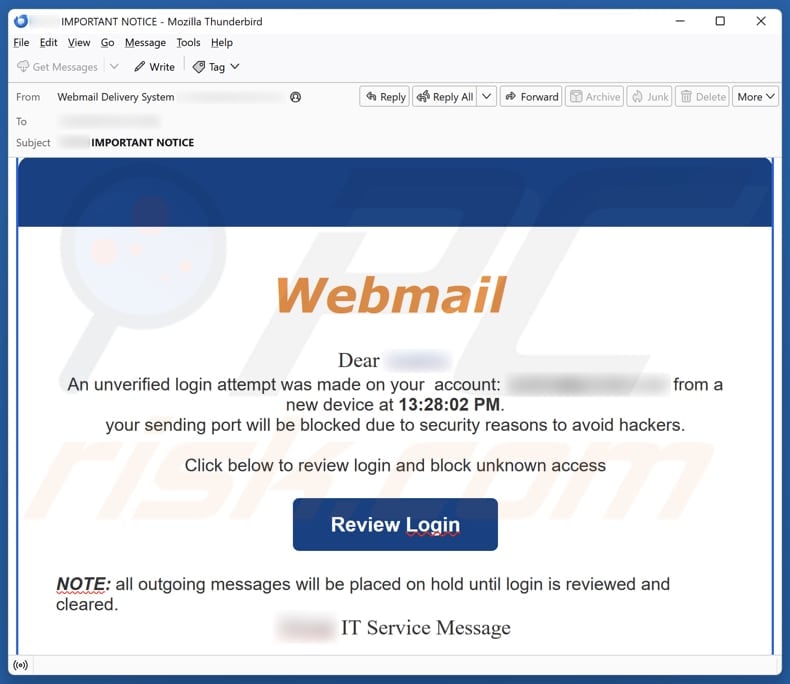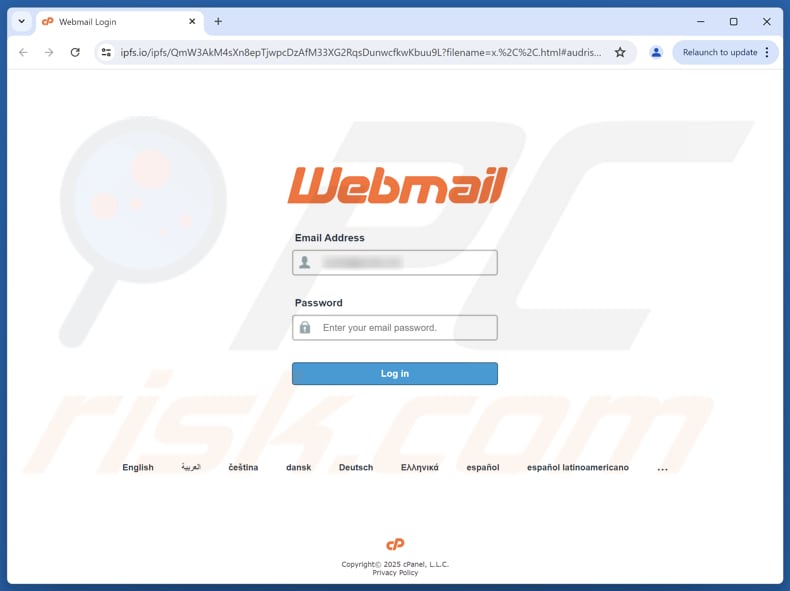How to spot scams like "Unverified Login Attempt" fake notification
Phishing/ScamAlso Known As: Unverified Login Attempt phishing email
Get free scan and check if your device is infected.
Remove it nowTo use full-featured product, you have to purchase a license for Combo Cleaner. Seven days free trial available. Combo Cleaner is owned and operated by RCS LT, the parent company of PCRisk.com.
What is "Unverified Login Attempt" scam?
Our team has reviewed the email and found that it is a fake message posing as an important notice regarding an unverified login attempt. It is disguised as a message from the recipient's email service provider. The goal is to trick recipients into opening a fake website and entering personal information on it.

More about the "Unverified Login Attempt" scam email
This email claims to be from an IT or email service team and reports an unverified login attempt from a new device. It warns that the recipient's sending capabilities will be blocked for security reasons and urges them to click a link ("Review Login" button) to review the login and prevent account restrictions.
Additionally, the email states that outgoing messages will be held until the account is verified. Its purpose is to trick the recipient into entering login credentials on a fraudulent page that poses as the Webmail login site (the site may imitate the recipient's email service provider, such as Gmail or Yahoo Mail).
If these details are stolen, scammers can hijack email accounts and misuse them to send malware, spread scams, steal other sensitive information, and more. They can also try to access social media, gaming, banking, or other accounts using the stolen credentials. In such cases, the potential damage might also include identity theft and monetary loss.
Overall, it is important to know how to recognize scam emails and never respond to them or open the provided links (or files).
| Name | Unverified Login Attempt Email Scam |
| Threat Type | Phishing, Scam, Social Engineering, Fraud |
| Fake Claim | An unverified login attempt was made on the recipient's account |
| Disguise | Notification from email security server |
| Symptoms | Unauthorized online purchases, changed online account passwords, identity theft, illegal access of the computer. |
| Distribution methods | Deceptive emails, rogue online pop-up ads, search engine poisoning techniques, misspelled domains. |
| Damage | Loss of sensitive private information, monetary loss, identity theft. |
| Malware Removal (Windows) |
To eliminate possible malware infections, scan your computer with legitimate antivirus software. Our security researchers recommend using Combo Cleaner. Download Combo CleanerTo use full-featured product, you have to purchase a license for Combo Cleaner. 7 days free trial available. Combo Cleaner is owned and operated by RCS LT, the parent company of PCRisk.com. |
Conclusion
This email is a phishing attempt designed to steal login credentials through a fake login page, giving scammers access to the email and potentially other connected accounts. Such access can lead to identity theft, financial loss, and further fraudulent activity. Sometimes, falling for such scams can lead to computer infections.
Examples of similar scams are "Webmail Server Report", "Check Inbox Failed Messages", and "Held Messages — Action Recommended".
How do spam campaigns infect computers?
Email can serve as a way for malware to infect a device when recipients interact with malicious content, such as files or links. Scam messages may contain infected attachments, such as documents, executable files, scripts, or compressed files like ZIP and RAR. Opening these files, or enabling features like macros in documents, can trigger the malware.
Additionally, clicking on malicious links can redirect users to fake websites that either automatically download malware or persuade the user to download it manually.
How to avoid installation of malware?
Exercise caution with unexpected or irrelevant emails, attachments, and links. Avoid opening files or clicking links in messages that seem suspicious. Use trusted antivirus or anti-malware programs, perform regular system scans, and keep your operating system, browser, and all applications up to date.
Do not interact with ads, pop-ups, or other content on untrustworthy websites, and refrain from allowing questionable sites to send notifications. Avoid using pirated software, cracks, or key generators.
Text presented in the "Unverified Login Attempt" email letter:
Subject: ******** IMPORTANT NOTICE
Webmail
Dear ********,
An unverified login attempt was made on your account: ******** from a new device at 13:28:02 PM.
your sending port will be blocked due to security reasons to avoid hackers.Click below to review login and block unknown access
Review Login
NOTE: all outgoing messages will be placed on hold until login is reviewed and cleared.
******** IT Service MessageThis message is automatically generated from the email security server. Any reply sent to this email cannot be delivered.
© ******** 2025. All rights reserved.
Deceptive website used in this scam:

Instant automatic malware removal:
Manual threat removal might be a lengthy and complicated process that requires advanced IT skills. Combo Cleaner is a professional automatic malware removal tool that is recommended to get rid of malware. Download it by clicking the button below:
DOWNLOAD Combo CleanerBy downloading any software listed on this website you agree to our Privacy Policy and Terms of Use. To use full-featured product, you have to purchase a license for Combo Cleaner. 7 days free trial available. Combo Cleaner is owned and operated by RCS LT, the parent company of PCRisk.com.
Quick menu:
- What is Unverified Login Attempt phishing email?
- Types of malicious emails.
- How to spot a malicious email?
- What to do if you fell for an email scam?
Types of malicious emails:
![]() Phishing Emails
Phishing Emails
Most commonly, cybercriminals use deceptive emails to trick Internet users into giving away their sensitive private information, for example, login information for various online services, email accounts, or online banking information.
Such attacks are called phishing. In a phishing attack, cybercriminals usually send an email message with some popular service logo (for example, Microsoft, DHL, Amazon, Netflix), create urgency (wrong shipping address, expired password, etc.), and place a link which they hope their potential victims will click on.
After clicking the link presented in such email message, victims are redirected to a fake website that looks identical or extremely similar to the original one. Victims are then asked to enter their password, credit card details, or some other information that gets stolen by cybercriminals.
![]() Emails with Malicious Attachments
Emails with Malicious Attachments
Another popular attack vector is email spam with malicious attachments that infect users' computers with malware. Malicious attachments usually carry trojans that are capable of stealing passwords, banking information, and other sensitive information.
In such attacks, cybercriminals' main goal is to trick their potential victims into opening an infected email attachment. To achieve this goal, email messages usually talk about recently received invoices, faxes, or voice messages.
If a potential victim falls for the lure and opens the attachment, their computers get infected, and cybercriminals can collect a lot of sensitive information.
While it's a more complicated method to steal personal information (spam filters and antivirus programs usually detect such attempts), if successful, cybercriminals can get a much wider array of data and can collect information for a long period of time.
![]() Sextortion Emails
Sextortion Emails
This is a type of phishing. In this case, users receive an email claiming that a cybercriminal could access the webcam of the potential victim and has a video recording of one's masturbation.
To get rid of the video, victims are asked to pay a ransom (usually using Bitcoin or another cryptocurrency). Nevertheless, all of these claims are false - users who receive such emails should ignore and delete them.
How to spot a malicious email?
While cyber criminals try to make their lure emails look trustworthy, here are some things that you should look for when trying to spot a phishing email:
- Check the sender's ("from") email address: Hover your mouse over the "from" address and check if it's legitimate. For example, if you received an email from Microsoft, be sure to check if the email address is @microsoft.com and not something suspicious like @m1crosoft.com, @microsfot.com, @account-security-noreply.com, etc.
- Check for generic greetings: If the greeting in the email is "Dear user", "Dear @youremail.com", "Dear valued customer", this should raise suspiciousness. Most commonly, companies call you by your name. Lack of this information could signal a phishing attempt.
- Check the links in the email: Hover your mouse over the link presented in the email, if the link that appears seems suspicious, don't click it. For example, if you received an email from Microsoft and the link in the email shows that it will go to firebasestorage.googleapis.com/v0... you shouldn't trust it. It's best not to click any links in the emails but to visit the company website that sent you the email in the first place.
- Don't blindly trust email attachments: Most commonly, legitimate companies will ask you to log in to their website and to view any documents there; if you received an email with an attachment, it's a good idea to scan it with an antivirus application. Infected email attachments are a common attack vector used by cybercriminals.
To minimise the risk of opening phishing and malicious emails we recommend using Combo Cleaner Antivirus for Windows.
Example of a spam email:

What to do if you fell for an email scam?
- If you clicked on a link in a phishing email and entered your password - be sure to change your password as soon as possible. Usually, cybercriminals collect stolen credentials and then sell them to other groups that use them for malicious purposes. If you change your password in a timely manner, there's a chance that criminals won't have enough time to do any damage.
- If you entered your credit card information - contact your bank as soon as possible and explain the situation. There's a good chance that you will need to cancel your compromised credit card and get a new one.
- If you see any signs of identity theft - you should immediately contact the Federal Trade Commission. This institution will collect information about your situation and create a personal recovery plan.
- If you opened a malicious attachment - your computer is probably infected, you should scan it with a reputable antivirus application. For this purpose, we recommend using Combo Cleaner Antivirus for Windows.
- Help other Internet users - report phishing emails to Anti-Phishing Working Group, FBI’s Internet Crime Complaint Center, National Fraud Information Center and U.S. Department of Justice.
Frequently Asked Questions (FAQ)
Why did I receive this email?
Receiving a fraudulent email suggests that your email has been harvested by scammers. These emails tend to be generic and sent to many addresses at once.
I have provided my personal information when tricked by this email, what should I do?
Change any account passwords if credentials were submitted. For other sensitive information, including financial or identification details, reach out to the appropriate entities.
I have downloaded and opened a malicious file attached to an email, is my computer infected?
Malicious executable files can infect a device immediately when opened. While typical Word or Excel files are less risky, enabling macros or similar functions can execute malware. The likelihood of infection depends on the file format.
I have read the email but did not open the attachment, is my computer infected?
Viewing an email alone does not pose a risk. Infection occurs only when a user interacts with a malicious file or follows a malicious link.
Will Combo Cleaner remove malware infections that were present in email attachment?
While Combo Cleaner can handle most known malware, running a complete system scan is essential to detect advanced (hidden) threats.
Share:

Tomas Meskauskas
Expert security researcher, professional malware analyst
I am passionate about computer security and technology. I have an experience of over 10 years working in various companies related to computer technical issue solving and Internet security. I have been working as an author and editor for pcrisk.com since 2010. Follow me on Twitter and LinkedIn to stay informed about the latest online security threats.
PCrisk security portal is brought by a company RCS LT.
Joined forces of security researchers help educate computer users about the latest online security threats. More information about the company RCS LT.
Our malware removal guides are free. However, if you want to support us you can send us a donation.
DonatePCrisk security portal is brought by a company RCS LT.
Joined forces of security researchers help educate computer users about the latest online security threats. More information about the company RCS LT.
Our malware removal guides are free. However, if you want to support us you can send us a donation.
Donate
▼ Show Discussion